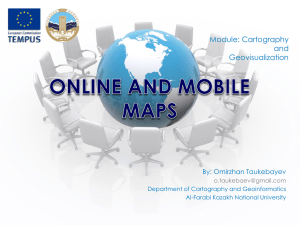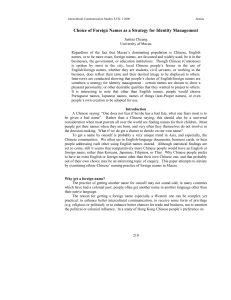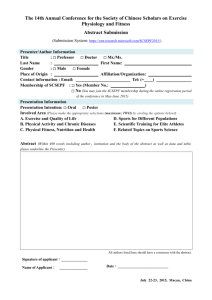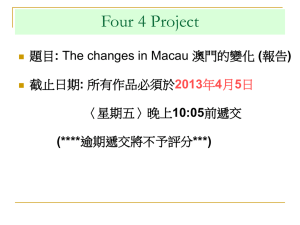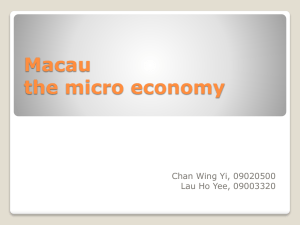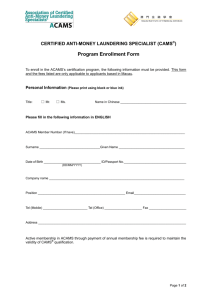The British presence in Macau (1635
advertisement
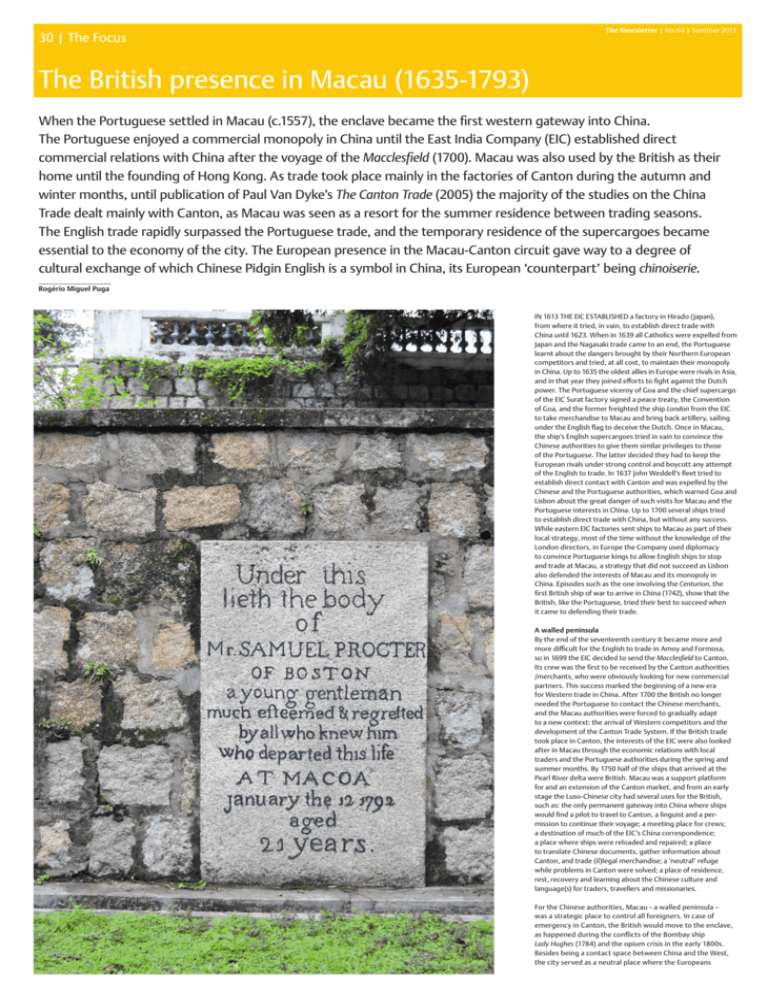
30 | The Focus The Newsletter | No.64 | Summer 2013 The British presence in Macau (1635-1793) When the Portuguese settled in Macau (c.1557), the enclave became the first western gateway into China. The Portuguese enjoyed a commercial monopoly in China until the East India Company (EIC) established direct commercial relations with China after the voyage of the Macclesfield (1700). Macau was also used by the British as their home until the founding of Hong Kong. As trade took place mainly in the factories of Canton during the autumn and winter months, until publication of Paul Van Dyke’s The Canton Trade (2005) the majority of the studies on the China Trade dealt mainly with Canton, as Macau was seen as a resort for the summer residence between trading seasons. The English trade rapidly surpassed the Portuguese trade, and the temporary residence of the supercargoes became essential to the economy of the city. The European presence in the Macau-Canton circuit gave way to a degree of cultural exchange of which Chinese Pidgin English is a symbol in China, its European ‘counterpart’ being chinoiserie. Rogério Miguel Puga In 1613 the EIC established a factory in Hirado (Japan), from where it tried, in vain, to establish direct trade with China until 1623. When in 1639 all Catholics were expelled from Japan and the Nagasaki trade came to an end, the Portuguese learnt about the dangers brought by their Northern European competitors and tried, at all cost, to maintain their monopoly in China. Up to 1635 the oldest allies in Europe were rivals in Asia, and in that year they joined efforts to fight against the Dutch power. The Portuguese viceroy of Goa and the chief supercargo of the EIC Surat factory signed a peace treaty, the Convention of Goa, and the former freighted the ship London from the EIC to take merchandise to Macau and bring back artillery, sailing under the English flag to deceive the Dutch. Once in Macau, the ship’s English supercargoes tried in vain to convince the Chinese authorities to give them similar privileges to those of the Portuguese. The latter decided they had to keep the European rivals under strong control and boycott any attempt of the English to trade. In 1637 John Weddell’s fleet tried to establish direct contact with Canton and was expelled by the Chinese and the Portuguese authorities, which warned Goa and Lisbon about the great danger of such visits for Macau and the Portuguese interests in China. Up to 1700 several ships tried to establish direct trade with China, but without any success. While eastern EIC factories sent ships to Macau as part of their local strategy, most of the time without the knowledge of the London directors, in Europe the Company used diplomacy to convince Portuguese kings to allow English ships to stop and trade at Macau, a strategy that did not succeed as Lisbon also defended the interests of Macau and its monopoly in China. Episodes such as the one involving the Centurion, the first British ship of war to arrive in China (1742), show that the British, like the Portuguese, tried their best to succeed when it came to defending their trade. A walled peninsula By the end of the seventeenth century it became more and more difficult for the English to trade in Amoy and Formosa, so in 1699 the EIC decided to send the Macclesfield to Canton. Its crew was the first to be received by the Canton authorities /merchants, who were obviously looking for new commercial partners. This success marked the beginning of a new era for Western trade in China. After 1700 the British no longer needed the Portuguese to contact the Chinese merchants, and the Macau authorities were forced to gradually adapt to a new context: the arrival of Western competitors and the development of the Canton Trade System. If the British trade took place in Canton, the interests of the EIC were also looked after in Macau through the economic relations with local traders and the Portuguese authorities during the spring and summer months. By 1750 half of the ships that arrived at the Pearl River delta were British. Macau was a support platform for and an extension of the Canton market, and from an early stage the Luso-Chinese city had several uses for the British, such as: the only permanent gateway into China where ships would find a pilot to travel to Canton, a linguist and a permission to continue their voyage; a meeting place for crews; a destination of much of the EIC’s China correspondence; a place where ships were reloaded and repaired; a place to translate Chinese documents, gather information about Canton, and trade (il)legal merchandise; a ‘neutral’ refuge while problems in Canton were solved; a place of residence, rest, recovery and learning about the Chinese culture and language(s) for traders, travellers and missionaries. For the Chinese authorities, Macau – a walled peninsula – was a strategic place to control all foreigners. In case of emergency in Canton, the British would move to the enclave, as happened during the conflicts of the Bombay ship Lady Hughes (1784) and the opium crisis in the early 1800s. Besides being a contact space between China and the West, the city served as a neutral place where the Europeans The Newsletter | No.64 | Summer 2013 The Focus | 31 were confined and solved their own problems, releasing the Chinese authorities from the burden of having to deal with foreigners. A walled city, Macau functioned as a lab-oratory for the Canton trade, where the Chinese authorities isolated and controlled Westerners while doing business with them. Before the creation of the Canton factories, the Luso-Chinese enclave had an important role when it came to control and keeping barbarians away from mainland China. The Chinese administration allowed the Portuguese to settle in a walled peninsula that could be easily controlled, and later drove the English and other foreigners there to be ‘ruled’ by the Portuguese. The city was therefore very important for the control of all Westerners between the trading seasons. Anglo-Portuguese alliance The enclave was vital for the EIC’s interests in China. In the second half of the 18th century the conflicts between the supercargoes and the Portuguese authorities increased as the British fought for greater freedom to develop their commercial interests, being forced to respect the Chinese law in Canton, and the Portuguese law in Macau. The British were continuously forced to fight for their interests in China, and Lord Macartney’s embassy (1793) was a part of this struggle to conquer better trading conditions. Once again, Britain looked to Macau as a desired territory, and it was also in the city that independent traders such as the Beale brothers and Jardine Matheson settled in the late 1770s to challenge the EIC’s monopoly until 1834. The Anglophone community influenced and enriched the social, economic and cultural life of nineteenth-century Macau, while the founding of Hong Kong, the signing of the Nanjing Treaty and the opening of the five Chinese ports transformed the Western way of life in the Sino-Portuguese enclave as well as its regional and international importance. The Anglo-Portuguese alliance, the oldest in the Western world, gradually extended to the Far East, where relations between old allies were shaped by the diplomacy of both Crowns, by the interests of local and Western merchants, and the Portuguese and Chinese laws. Luso-English relations in Macau were also influenced by the imperial policies (edicts), and the Portuguese often used the will and law of the Chinese as an excuse to defend their privileged status in China. Macau also worked as a decompression chamber for Westerners who arrived in China, and for Chinese who left mainland China and had a quick glimpse at how Europeans lived. Therefore, the history of the Gem of the Orient – as Sir John Bowring, one of the first Hong Kong governors, called Macau in his Sonnet to Macao – can only be studied based on multi-archival research, both Western and Eastern, and approached like a kaleidoscopic and complex reality, with local, regional and (inter)national dimensions. Rogerio Miguel Puga is Senior Researcher at the Centre for English, Translation, and Anglo-Portuguese Studies, New University of Lisbon. He is also editor of the European Journal of Macao Studies. This article is a summary of some chapters from the author’s forthcoming book The British in Macau, 1635-1793 (London: Royal Asiatic Society – Hong Kong: Hong Kong University Press, 2013). (rogerio_puga@hotmail.com) Opposite and above: Grave markers at Macau’s Old Protestant Cemetery, established by the British East India Company in 1821. Middle: Morrison Chapel, built in 1921 and named for Robert Morrison, a missionary from the UK who translated the Bible into Chinese. Below: Macau’s Old Protestant Cemetery, today part of Macau’s UNESCO World Heritage Site.
